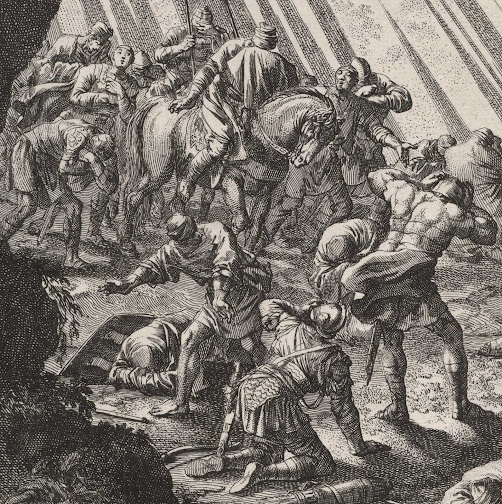Jan
Luyken (aka
Johannes Luyken; Jan Luijken) (1649–1712)
“The
Conversion of St Paul” (aka “La Conversion de Saint Paul”; “Paulus
Bekeering” [titles inscribed in French and Dutch on plate]; “St. Paul on Road
to Damascus”), 1708, plate 58 from a series of sixty-two Old and New Testament
biblical prints first published by Pieter Mortier (1661–1711)
in 1708. This impression is from either the 1729 or the 1743 edition published
by Jan Covens (1697–1774) and Corneille
Mortier (fl.1688–c1743) in “Biblia Sacra, dat is, de H.
Schriftuer van het Oude, en het Nieuwe Testament, naer de laetste Roomsche
keure der gemeine Latijnsche overzettinge, in nederduitsch vertaeld (...)”.
(Note that this information is based on another dealer’s description selling
the same print from the later 1743 edition: https://www.1stdibs.com/furniture/wall-decorations/prints/antique-bible-print-conversion-paul-j-luyken-1743/id-f_9329201/.)
Etching on fine laid paper with wide margins
and flattened centrefold.
Size: (sheet) 49 x 56.9 cm; (plate) 34.3 x
44.3 cm; (image borderline) 32.9 x 43.4 cm.
Lettered on plate below the image borderline:
(left) “Edit. à J. Covens et C. Mortier.”; (left of centre) “Paulus Bekeering.
Handeling: IX.v: 4.”; (right of centre) “La Conversion de Saint Paul. Actes
[sic] IX. vs: 4.”; (right) “Johannes Luyken Inv. et Fecit./ 58.”
State ii (of ii) with the change of publisher
from Pieter Mortier I to his son, Corneille Mortier and Corneille’s
brother-in-law, Jan Covens, and the erasure of the privilege. Lifetime/early
impression (based on the crisp quality of the lines showing no sign of wear to
the printing plate).
Van Eeghen 3740 (Pieter van Eeghen & Johan
Philip van der Kellen 1905, “Het werk van Jan en Casper Luyken”, Amsterdam,
Frederik Muller & Co., vol. 2, p. 665, cat. no. 3740).
This publication is available for online
viewing or free download at archive.org (note that the page numbering is
challenging and the URL below may be helpful):
https://archive.org/details/gri_33125001866108/page/n295/mode/2up (see
cat. no. 3740).
Condition: richly inked and well-printed, near
faultless impression with generously wide margins and with the centre-fold of
publication flattened. The sheet in near pristine/museum quality condition.
I am selling this museum-quality etching in an
exceptionally fine state of preservation for AU$281 (currently US$198.57/EUR188.25/GBP157.97
at the time of this listing) including postage and handling to anywhere in the
world (but not, of course, any import duties/taxes imposed by some countries).
If you are interested in purchasing this
spectacular etching portraying an unworldly blinding light—note how Luyken
convincingly suggests a blazing spiritual light by strong tonal contrast and by
contrast between the mechanically straight lines of the shafts of light with
the organic curves of the silhouetted tree at left and the turmoil of
fragmented curves of the soldiers below—please contact me
(oz_jim@printsandprinciples.com) and I will send you a PayPal invoice to make
the payment easy.
This is the second impression of this huge
etching that I have listed. The previously listed copy has been sold.
This print has been sold



















































